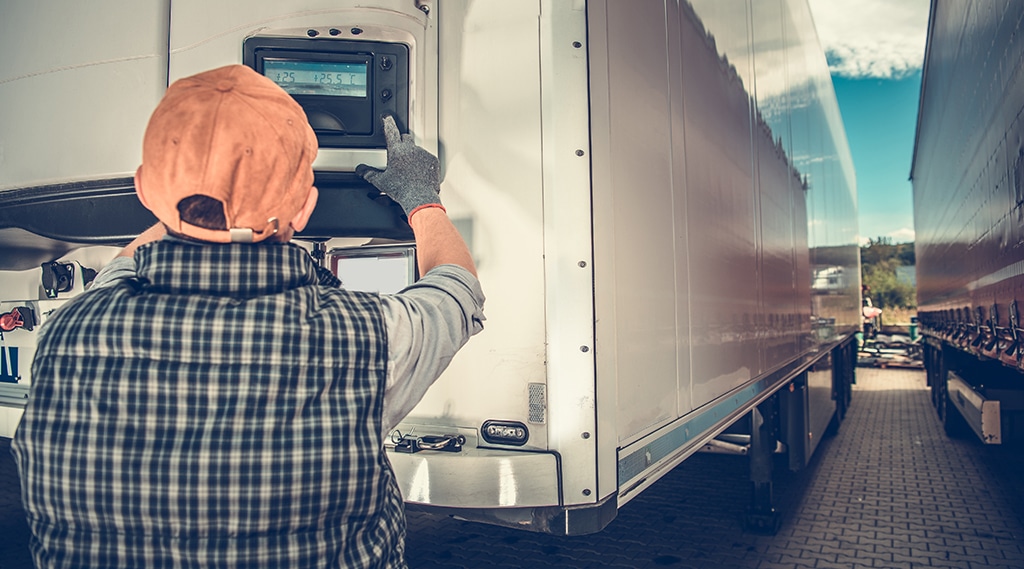Regardless of what type of semi trailer you’re hauling, it’s important to load it correctly. Improper loading can lead to various problems including damage to the freight or the trailer, injuries to people tasked with unloading the trailer at your destination, etc.
Proper loading of a refrigerated semi trailer (frequently referred to as a “reefer” trailer) is especially important. Not only can items shift or fall if the trailer contents aren’t arranged correctly, but cooled items can also reach unsafe temperatures and spoilage can occur if you aren’t careful.
Below are eight steps you should take every time you use a reefer trailer—whether it’s one in your fleet or a leased or rented semi trailer.
The Right Way to Load a Reefer Semi Trailer
If you do the following when loading a reefer semi trailer, you’ll help ensure that the goods you’re hauling stay properly cooled and that your equipment doesn’t have to work overtime to keep them that way.
- Pre-cool your cargo. Reefer semi trailers are not designed to chill warm goods, but rather to keep chilled goods cool. In other words, if items are meant to be kept at 40 degrees Fahrenheit during their journey, they should be at that temperature when they’re loaded. This is best for them and also for the semi trailer’s refrigeration unit.
- Minimize cargo dock time. Ensuring that your cargo is pre-cooled isn’t helpful if it’s then allowed to sit on a warm loading dock for an extended period. As much as possible, time your loading so that cargo can be moved from cold storage to your cold semi trailer quickly and efficiently.
- Pre-cool the cargo space. The residual heat in the floor, walls and ceiling of a reefer semi trailer can transfer to the cargo you load. Consequently, it’s important to get the trailer to the desired transport temperature before you load it. A certain amount of warming may occur during the loading process, but it will be minimal and the trailer’s cooling unit can catch up easily.
- Ensure proper spacing. The key to keeping goods cool in a reefer semi trailer is airflow. Anything that inhibits airflow creates the risk of hotspots developing in the trailer. Consequently, you should position your cargo so that there is at least 2 inches of space between the goods and the trailer sidewalls, 4 inches of clearance from the rear doors, and 9 inches of overhead clearance.
- Use pallets if appropriate. If the floor of the trailer you’re using is flat, you should load cargo onto pallets so that air can flow easily under the goods. Again, unimpeded airflow is essential.
- Be mindful of cooling equipment function. It’s important that you understand how the cooling system on your reefer semi trailer works and ensure that cargo doesn’t interfere with that work. For example, goods should not block the cooling system’s evaporator outlet.
- Use an air chute. An air chute is a flexible polyethylene, vinyl or mesh duct that is positioned above the cargo and runs from front to back in the trailer. It facilitates uniform air movement throughout the space and helps ensure even cooling.
- Shut down the refrigeration unit during unloading. It’s best to shut down the cooling unit when you reach your destination. Leaving it running with the doors open at the end of a trip can cause it to pull in warm, humid air that can freeze on the unit’s evaporator coil. This can impair cooling performance, including causing the cooling unit to frequently go into defrost mode, during which it isn’t providing cooling.
Hauling a Reefer Semi Trailer: Ensuring Proper Cooling at the Start and Along the Way
If the reefer semi trailer you’re hauling is one you haven’t used before, be sure you understand all of its features and functions. For example, many reefers offer cooling in either automatic or continuous mode. In automatic mode, the unit operates as needed. This mode takes less fuel and shortens the engine run time. In continuous mode, the engine and refrigeration system are always running. This mode uses more fuel but is necessary when a load needs precise, unwavering temperature control.
Also, most reefer semi trailers require that you press Enter after changing the temperature setting. Unlike a home thermostat, on which all you have to do is press the up or down button, a cooling unit requires that you press Enter to confirm the change.
And these are just a few pointers. Getting familiar with your reefer trailer before you start your trip can save you time and protect your payload if you need to change settings or take other actions while on the road. The last thing you want is to be hauling perishables on a blazing hot July day and have a problem arise that you don’t know how to handle!
Speaking of being on the road… A well-maintained reefer semi trailer, like we offer for rent or lease at Boxwheel Trailer Leasing, will have no problem keeping your cargo cool, even on a long trek. However, since the most carefully loaded cargo can shift at times, it’s important to check on your load periodically to ensure that it’s staying cool. For example, if part of a pallet were to buckle and its contents then became a “roadblock” to ground-level airflow, that could change the cooling dynamic in the trailer.
Get the Right Reefer Semi Trailer for the Job!
None of the advice above will help you complete a job successfully if you don’t have a high-quality reefer semi trailer that can accommodate the goods you need to haul. If you have questions about reefer trailers—from specs to how to operate them—our team at Boxwheel is happy to provide answers. We can help you determine what equipment will meet your needs, and then our three-step process makes it simple to pick up a semi trailer and get on the road.
And we offer more than just reefer trailers. If you need a flatbed, liftgate or dry van trailer from great names like Wabash, Utility and Great Dane, we can help you with that, too. Contact us today to learn about our large inventory of rental semi trailers and semi trailers for sale.

